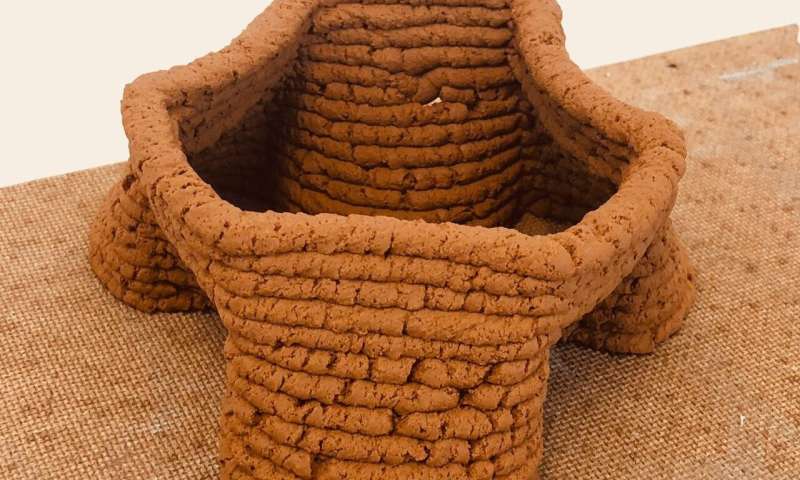
The construction industry is currently facing two major challenges: the demand for sustainable infrastructure and the need to repair deteriorating buildings, bridges and roads. While concrete is the material of choice for many construction projects, it has a large carbon footprint, resulting in high waste and energy expenditure. Today, researchers report progress toward a sustainable building material made from local soil, using a 3-D printer to create a load-bearing structure.
The researchers will present their results today at the American Chemical Society (ACS) Fall 2020 Virtual Meeting & Expo.
"The environmental impact of the construction industry is an issue of growing concern," says Sarbajit Banerjee, Ph.D., the project's principal investigator. "Some researchers have turned to additive manufacturing, or building structures layer by layer, which is often done with a 3-D printer. That advance has begun to transform this sector in terms of reducing waste, but the materials used in the process need to be sustainable as well."
For example, construction projects using extruded layers of concrete have highlighted the potential of additive manufacturing for building structures quickly and cheaply. However, concrete manufacturing is responsible for approximately 7% of carbon dioxide emissions according to the International Energy Agency, and cannot be recycled.
"Historically, humans used to build with locally sourced materials, such as adobe, but the move to concrete has raised many environmental issues," says Aayushi Bajpayee, a graduate student in Banerjee's lab at Texas A&M University. She is presenting the work at the meeting. "Our thought was to turn the clock back and find a way to adapt materials from our own backyards as a potential replacement for concrete."
An advantage to using local soil in construction is that the materials would not need to be manufactured and transported to the building site, reducing both costs and environmental damage. Banerjee and Bajpayee also say that additive manufacturing with soil could one day be used beyond Earth, to create settlements on the moon or even Mars.
Soil is typically classified by the layers of materials it comprises, beginning with the top organic layer where plants grow and ending at the hard bedrock of the earth's crust. Beneath the initial organic layer is clay, which gives soil its plastic, moldable character that the researchers capitalized on in their project.
The researchers began by collecting soil samples from a colleague's backyard and tailoring the material with a new environmentally friendly additive so that it would bind together and be easily extruded through the 3-D printer. Because soils vary greatly by location, their aim was to have a chemistry "toolkit" that could transform any type of soil into printable building material. From there Bajpayee built small-scale test structures, cubes measuring two inches on each side, to see how the material performed when extruded into stacked layers.
The next step was to ensure that the mixture is load bearing, meaning that it will stand up to the weight of the layers but also other materials used in construction such as rebar and insulation. To help with this, the researchers strengthened the clay mixture by "zippering" the microscopic layers on its surface to prevent it from absorbing water and expanding, which would compromise the printed structure. With this method, the researchers showed that the material could hold twice as much weight as the unmodified clay mixture.
Next, the team plans to improve the soil's load-bearing capabilities in order to scale up their test structures and get as close to a replacement for concrete as possible. In addition, they are gathering data to see whether these 3-D printed structures are as environmentally friendly as they envision, especially in terms of carbon footprint and recycling potential. Once they have a better picture of the chemistry, functionality and feasibility of building with local soils, they plan to further explore how this technology can be used beyond our own planet.
More information: In situ resource utilization and reconfiguration of soils into construction materials for the additive manufacturing of buildings:
Abstractr
The construction industry is being buffeted by winds of change, balancing the urgent need to remedy deteriorating infrastructure in the developed world and the push to build new infrastructure in emerging economies whilst devising means to better its catastrophic carbon footprint and inefficiencies across the construction process that result in considerable waste and energy expenditure. Additive manufacturing methods stand out to transform the industry by enhancing automation, however, reliance on concrete as the extrusive material of choice has the potential to compound mounting environmental challenges. We discuss our efforts to develop a new palette of naturally sourced construction materials based on natural soils, which are reconfigured into extrudable formulations compatible with additive manufacturing. We delineate a roadmap bringing together soil chemistry with composite science, modeling of mesoscale phenomena, rheological studies of extrudable soil inks, generative design, and the development of robust structure-function correlations relating atomistic and mesoscale structures as well as geometry of the architectures to load-bearing capabilities. We illustrate this approach using a naturally harvested burlewash clay sample crosslinked through formation of a siloxane framework which has been 3D printed into a load-bearing structure. The need for an integrated life cycle assessment approach is emphasized to ensure development of a new palette of sustainable construction materials.